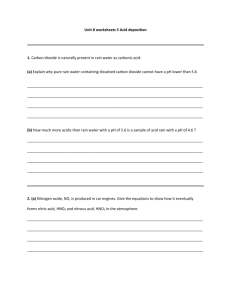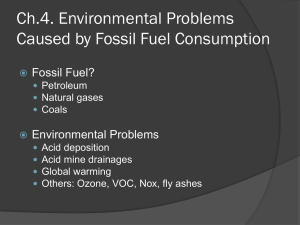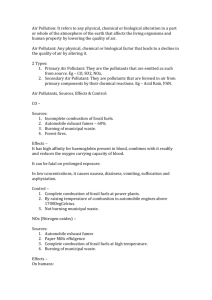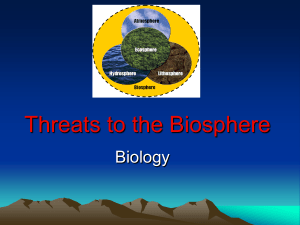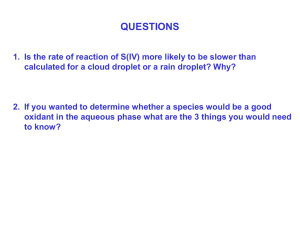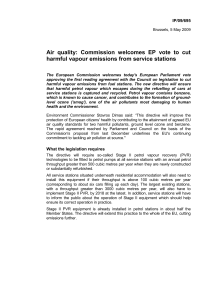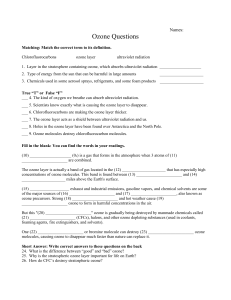AIR Pollution
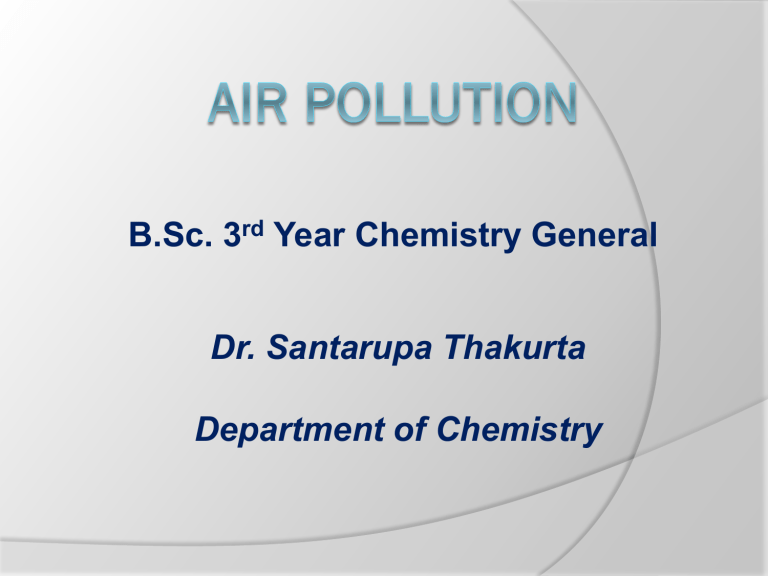
B.Sc. 3
rd
Year Chemistry General
Dr. Santarupa Thakurta
Department of Chemistry
It is the contamination of air by the discharge of harmful substances.
Air pollution can cause health problems and it can also damage the environment and property.
Modernisation and progress have led to air getting more and more polluted over the years.
Industries, vehicles, increase in the population, and urbanization are some of the major factors responsible for air pollution.
1. Sulphur di oxide (SO
2
):
Source-
• Fossil fuel combustion at power plants (73%).
• Industrial processes such as extracting metal from ore.
• An erupting volcano can also emit high levels of SO
2
.
Harmful effects-
Can lead to lung diseases.
NO
X
2. Nitrogen oxide (NO x
): represents composite atmospheric gases, nitric oxide NO and nitrogen di oxide NO
2
.
Source-
Produced from combustion of petrol, diesel from vehicles.
Harmful effects-
Can make children susceptible to respiratory diseases in winters.
3.
Carbon mono oxide (CO):
Source-
• Produced by the incomplete combustion of carbon-based fuels including petrol, diesel, and wood.
• From the combustion of natural and synthetic products such as cigarettes.
C
4
H
10
+ 6O
2
3 CO
2
+ CO + H
2
O
Harmful effects-
CO can cause harmful health effects by reducing oxygen delivery to the body's organs (like the heart and brain) and tissues.
At extremely high levels, CO can cause death.
Hb (Haemoglobin) + CO = [Hb.CO]
4.
Suspended Particulate Matter (SPM):
• Complex mixture of extremely small particles and liquid droplets
• Range in size from a diameter of 0.00002
to 500
.
Source-
Particle pollution is made up of a number of components, including fly ash (containing Fe
2
O
3
, P
4
O
10 etc
.
), polycyclic aromatic hydrocarbons, and soil or dust particles.
Harmful effects-
Particles that are 10 micrometers in diameter or smaller can pass through the throat and nose and enter the lungs.
Once inhaled, these particles can affect the heart and lungs and cause serious diseases like asthma, silicosis.
Photochemical smog was first described in the 1950s, characterised by brown hazy fumes.
It is the chemical reaction of sunlight, nitrogen oxides and volatile organic compounds in the atmosphere, which leaves airborne particles and ground-level ozone.
NO
2 h
NO + O, O
2
+ O
O
3
3CH
4
+ 2O
3
3 CH
2
=O + 3H
2
O
This noxious mixture of air pollutants can include the following:
Nitrogen oxides
Tropospheric ozone
Formaldehyde, acrolene
Peroxyacetyl nitrate (PNA)
Adverse effects:
All of these harsh chemicals are usually highly reactive and oxidizing.
It can inflame breathing passages, decrease the lungs' working capacity, cause shortness of breath, pain when inhaling deeply, wheezing, and coughing. It can cause eye and nose irritation.
Photochemical smog is considered to be a problem of modern industrialization. It is more common in cities with sunny, warm, dry climates and a large number of motor vehicles.
Acid rain occurs when the gases SO
2 and NO x react in the atmosphere with water, oxygen, and other chemicals to form various acidic compounds.
The result is a mild solution of sulphuric acid and nitric acid.
2NO
2
+O
3
+ H
2
O
2HNO
3
+ O
2
2SO
2
SO
3
+ O
2
+ H
2
SO
3
O
H
2
SO
4
Adverse effects:
Both the lower pH and higher aluminium concentrations in surface water that occur as a result of acid rain can cause damage to fish and other aquatic animals .
Soil biology & chemistry can be seriously damaged by acid rain.
Some microbes, unable to tolerate changes to low pH, are killed.
The hydronium ions of acid rain also mobilize toxins, such as aluminium, and leach away essential nutrients and minerals such as magnesium.
High altitude forests are especially vulnerable as they are often surrounded by clouds and fog which are more acidic than rain.
Other plants and food crops can also be damaged.
Adverse effects:
Acid rain can damage buildings, historic monuments, and statues, especially those made of rocks, such as limestone and marble, that contain large amounts of calcium carbonate. Acids in the rain react with the calcium compounds in the stones to create gypsum, which then flakes off.
CaCO
3
(s) + H
2
SO
4
(aq)
CaSO
4
(s) + CO
2
(g) + H
2
O (l)
Acid rain also increases the corrosion rate of metals, in particular iron, copper and bronze.
Stratospheric ozone is being destroyed by a group of manufactured chemicals, containing chlorine and/or bromine.
List of Ozone Depleting Substances:
Chlorofluorocarbons (CFCs) o Used as coolants in refrigerators, freezers and air conditioners in buildings and cars manufactured before 1995.
o Found in industrial solvents, dry-cleaning agents and hospital sterilants. o Also used in foam products — such as soft-foam padding (e.g. cushions and mattresses) and rigid foam (e.g. home insulation).
Halons
Used in some fire extinguishers
Methyl Chloroform
Used mainly in industry — for vapour degreasing, some aerosols, cold cleaning, adhesives and chemical processing.
Carbon Tetrachloride
Used in solvents and some fire extinguishers.
Stratospheric ozone filters out most of the sun's potentially harmful shortwave ultraviolet (UV) radiation . If this ozone becomes depleted, then more UV rays will reach the earth.
Exposure to higher amounts of UV radiation could have serious impacts such as the following:
More skin cancers, sunburns and premature aging of the skin.
Damage of several parts of the eye, including the lens, cornea, retina and conjunctiva.
Weakening of the human immune system.
Plankton (tiny organisms in the surface layer of oceans) are threatened by increased UV radiation.
Wood, plastic, rubber, fabrics and many construction materials are degraded.
Carbon di oxide and water vapour strongly absorb infra red radiation (14000 – 250000 nm) and effectively block a large fraction of earth’s emitted radiation. The radiation thus absorbed by CO
2 and H
2
O vapour is partly re-emitted to earth’s surface. This results in an elevation of earth’s surface temperature.
Human activities, primarily the burning of fossil fuels and clearing of forests, have intensified the natural greenhouse effect, causing global warming .
The effects of global warming are the environmental and social changes caused (directly or indirectly) by human emissions of greenhouse gases. Many impacts of climate change have already been observed, including glacier retreat, changes in the timing of seasonal events (e.g., earlier flowering of plants), and changes in agricultural productivity.
Threats caused by rise of temperature:
Hampering of world food production.
Decrease of the biological productivity of ocean.
The rise in sea levels would submerge coastal countries.
The pollutants CO, NO and NO
2 emitted from cars can be converted to non-polluting CO
2
, H
2
O, NH
3 and N
2 through catalytic converter using finely divided platinum as catalyst,
Use of low-sulphur containing coal to minimise SO
2 pollution.
Use of alternative energy sources such as hydrothermal plants and Nuclear power plants.
For control of Particulate emissions electrostatic precipitator and cyclone collector are employed.
More plantation of trees to maintain balance in the atmospheric
CO
2 level.
